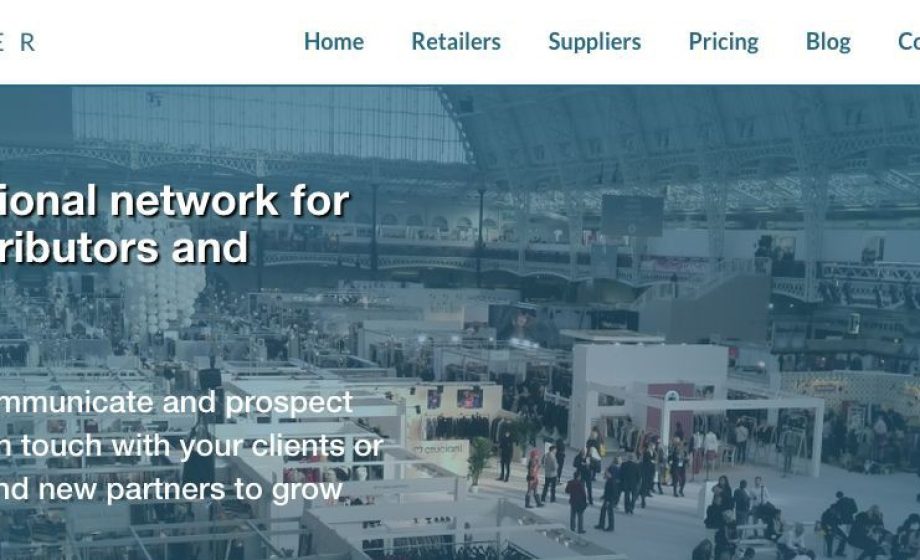
In recent years, the fashion industry has sought to eschew its traditional, closed, risk-adverse image as it relates to tech. Whether it be LVMH’s investment in Lyst, the fashion marketplace Farfetch newly minted unicorn status, the global success of the private sale model (see Showroomprive.com, Venteprivee, Mei.com, VIP Plaza, etc), the growing importance of 3D printing, or the rise of fashion-friendly social media like Pinterest, the fashion industry appears to have wholeheartedly embraced the promise digital offers their industry. Well, at least in the B-to-C part of the industry. What about B-to-B, which is arguably the lifeblood of the sector? Despite the rise of leading online media source for fashion professionals The Business of Fashion, and the launch of a few B-to-B marketplaces such as Lookbooks.com or Dering Hall (home furnishings), the B-to-B side of fashion is still ripe for disruption.
Founded just 1 year ago by Tal Levy (CEO), Grégoire Chauvin (Managing Director), and Emilien Bouard (CTO), Uppler, a B-to-B marketplace and network for fashion professionals around the world, is on a mission to lead this disruption. From helping suppliers/brands to create their own, customized showrooms on their platform to enabling small and large retailers alike to directly access brands from around the world, Uppler is quickly becoming an important actor in the sector, easing the transactional relationship between fashion buyers and sellers. Uppler also allows fashion buyers to purchase directly on their platform, a key functionality which helps to eliminate one of the big problem areas in the transaction process for many buyers and sellers. Uppler’s Grégoire Chauvin sums up the state of play in B-to-B fashion commerce adding:
“It’s still hard to find brands, good information on what sells, and have brands accept you as a distributor. Things are still quite old-fashioned. Surprisingly, there are still very few tools focusing on B-to-B fashion or e-commerce, with the exception of perhaps Alibaba. There are a lot of people saying that B-to-B e-commerce will be the next big thing, but there’s still not much innovation in this area.”
 Uppler has grown impressively since its launch, recently announcing 2k brands and 30k retailers on their platform from 110 countries as well as an average 40% monthly increase in turnover. Unlike many marketplaces, they’ve opted for a monthly subscription-based model for suppliers rather than taking a percentage of the transaction, an extremely difficult approach to put in place in a sector where negotiation plays a big role in the final transaction price.
Uppler has grown impressively since its launch, recently announcing 2k brands and 30k retailers on their platform from 110 countries as well as an average 40% monthly increase in turnover. Unlike many marketplaces, they’ve opted for a monthly subscription-based model for suppliers rather than taking a percentage of the transaction, an extremely difficult approach to put in place in a sector where negotiation plays a big role in the final transaction price.
Up until now, their user acquisition strategy has centered around recommendation-only, whereby retailers and suppliers who currently have a working relationship can invite each other to the platform. However, they will soon be expanding more broadly to begin recruiting new users via tradeshows during industry Market Weeks, such as the massive Magic Market Week in Las Vegas and Coterie in NYC. As these mega-shows can be very difficult to navigate for both buyers and sellers, they will aim to find ways to better to connect attendees during the tradeshow via tools which the Uppler team are currently developing. They stress that these tools will not only help suppliers and retailers connect when at the show, but will also help them maintain and develop their relationship once the show wraps-up, often a big challenge for many fashion professionals.
 Most of the brands on their platform currently lean toward mid-range apparel and accessories brands, but they’re now gaining more high-end fashion brands, and are expanding to cosmetics, furniture and home decoration which have very similar distribution models. As the fashion industry is highly international, Uppler has been global from day 1 and aims to be even more so through extending their presence in, at a minimum, the top fashion marketplace hubs in the US, Europe and Asia.
Most of the brands on their platform currently lean toward mid-range apparel and accessories brands, but they’re now gaining more high-end fashion brands, and are expanding to cosmetics, furniture and home decoration which have very similar distribution models. As the fashion industry is highly international, Uppler has been global from day 1 and aims to be even more so through extending their presence in, at a minimum, the top fashion marketplace hubs in the US, Europe and Asia.
In addition to rolling out their user acquisition strategy, one of their next big steps is to enhance their R&D in order to better match suppliers/brands and retailers with an improved recommendation algorithm. They also plan to build-out the analytics of their platform, giving suppliers and brands more intelligence on how their products are selling through to the end-consumer. Currently they have a dual head-office structure with 10 in Paris, focusing on engineering and product development, and a growing sales and marketing team in Tel Aviv.
B2B fashion marketplace Uppler crosses the 2000 brand mark

Uncategorized
